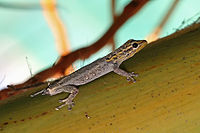
Appendage regeneration in anamniotes utilizes genes active during larval‐metamorphic stages that have been lost or altered in amniotes: The case for studying lizard tail regeneration
Sign Up to like & getrecommendations! Published in 2020 at "Journal of Morphology"
DOI: 10.1002/jmor.21251
Abstract: This review elaborates the idea that organ regeneration derives from specific evolutionary histories of vertebrates. Regenerative ability depends on genomic regulation of genes specific to the life‐cycles that have differentially evolved in anamniotes and amniotes.… read more here.
Keywords: lizard tail; regeneration anamniotes; tail regeneration; regeneration ... See more keywords

Immunolocalization of adenomatous polyposis coli protein (apc) in the regenerating lizard tail suggests involvement in tissue differentiation and regulation of growth
Sign Up to like & getrecommendations! Published in 2022 at "Journal of Morphology"
DOI: 10.1002/jmor.21465
Abstract: Lizard tail regeneration is likely regulated by the balanced activity of oncogenes and tumor suppressors that control cell proliferation avoiding tumorigenic degeneration. One of the main tumor suppressor genes present in the regenerating tail is… read more here.
Keywords: adenomatous polyposis; lizard tail; protein apc; differentiation ... See more keywords

Biomimetic fracture model of lizard tail autotomy
Sign Up to like & getrecommendations! Published in 2022 at "Science"
DOI: 10.1126/science.abh1614
Abstract: Lizard tail autotomy is an antipredator strategy consisting of sturdy attachment at regular times but quick detachment during need. We propose a biomimetic fracture model of lizard tail autotomy using multiscale hierarchical structures. The structures… read more here.
Keywords: lizard tail; model; fracture; tail ... See more keywords